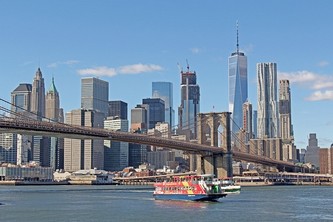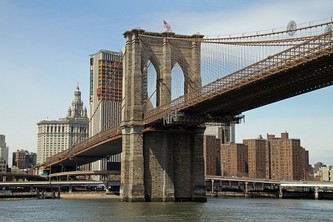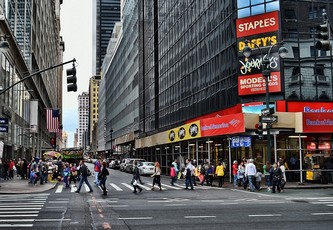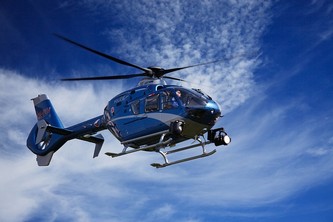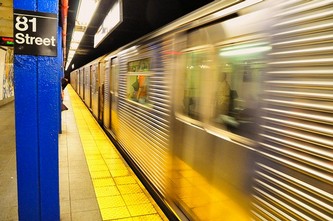Attractions in New York

FAMOUS
The Brooklyn Bridge , is a suspension bridge
with a length of 1825 meters
complex that connects the east side of Manhattan with the borough of Brooklyn. The bridge is on two levels.
At the base level are the lanes for
cars moving from Brooklyn to Manhattan and back, about 145,000 per day; the top lane,
much tighter,
it is instead reserved for
pedestrians and cyclists. Inaugurated in 1883, its construction took 13 years. And in fact,
for the technologies available at the time, it was a pharaonic work. At that time it was in fact the bridge
longest suspended in the world.

Symbol of New York and the entire states
United States of America, the Statue
of Liberty is positioned
within the small island Liberty Island, in the Upper New York Bay and represents a
of the major attractions of the city. The statue depicts a woman dressed as a
long toga holding up in
hand a torch, symbol of freedom while in the other he holds a book engraved with 4
July 1776, the date of American independence.
At her feet are broken chains, a symbol of liberation from the tyrant. The statue is
work of Gustave Eiffel, the same as the tower
Eiffel in Paris and was donated by France to the United States of America on the occasion of the
100th anniversary of independence.
The base was instead the work of Richard Morris Hunt in 1875. A detail: the torch carried in the hand of the statue is not
the original one. It was replaced in 1916 because it was damaged. The original one can still be visited in the museum dedicated to
Statue of Liberty on Libert Island. Currently an internal lift leads to the top floor of the basement and then to the torch
from which it is possible to admire the skyline of Manhattan. Also nicknamed Lady Liberty,
is a huge statue 46 meters high and resting on an equally huge pedestal that
makes the total height pass to 93 meters.


The Rockefeller Center is a set of 19 primarily used buildings
commercial and executive office located between 48th and 51st streets and between Fifth Avenue and Sisth Avenue in Manhattan -
New York City. The most interesting entrance is certainly the one on Fifth Avenue from which you arrive at the Promenade,
pedestrian area characterized by fountains, bronze statues and water basins. From the Promenade it is possible to get to the Lower Plaza.
The square is dominated by the bronze statue Prometheus, the symbol of Rockefeller Center. In this square at Christmas it is installed
a huge Christmas tree. The first part was built by Jhon D. Rockefeller Jr. starting in 1931.
These are skyscrapers
mostly in Art Deco, characteristic attractions of the city. The second part was added instead in the sixties. Currently the Rockefeller Center, pur
maintaining its original philosophy, it is a must for tourists especially because it is
It is possible to carry out guided visits to the NBC studios and participate in the Radio City Music All shows.
Before September 11, 2001, the Lower Manhattan skyline was dominated by the imposing size of the twin towers,
Twin towers, which soared above the World Trade Center. New York City hasn't been the same since that day. The skyline has changed,
instead of the World Trade Center yes
finds Ground Zero, a huge hole tens of meters deep, fenced off. A cross stands out from the bottom.
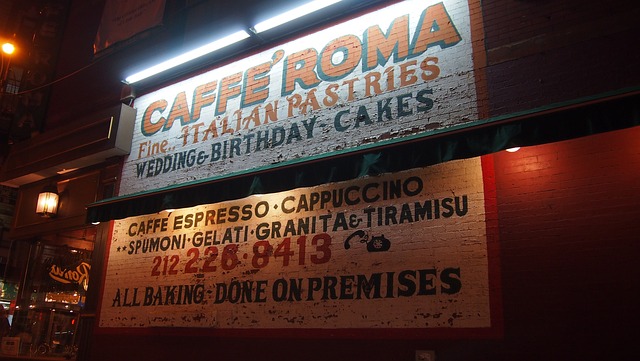
CENTRAL PARK
Located right in the center of Manhattan, Central Park is a huge rectangular park, an oasis of peace and
green for the citizens of Manhattan and New York City. Central Park was the first park built in a small town
American in 1856. Inside there are numerous lakes, paths and hills which, although they seem natural,
they are actually the work of man. Its main feature is to completely cut through the dense expanse of
skyscrapers of Manhattan, which makes its view extremely special,
with walls of skyscrapers that entirely surround the perimeter of the park, as if to protect it.
CHINATOWN
New York City's Chinatown is located in Lower Manhattan and covers, more or less, the area
located between Chatham Square, Worth Street, Baxter Street, Chanal Street and Bowery although in recent years it has expanded
covering large spaces of Little Italy. The atmosphere in Chinatown is extremely special, with signs
Chinese and bright colors.
It is worth visiting this district especially during the Chinese New Year which is celebrated between the end of January and
the beginning of February.
LITTLE ITALY
Little Italy , in New York City is a small neighborhood in southern Manhattan, characterized by a
very high concentration of Italian immigrants and Italian commercial activities that have tried to maintain the
traditions of their country of origin. Of particular importance is the feast of San Gennaro which takes place every year from 12
to September 26th. Note that although Manhattan's Little Italy is most famous, there are others in New York City
concentrations of Italian immigrants, such as Little Italies in the Bronx. Arrived in New York with the greats
immigration in the late nineteenth and early twentieth centuries, Italians in America have always tried to concentrate.
Little Italy is an expression of this characteristic. It should be noted that today the Italians in America are not the same
arrived here almost a century ago. They are their children or grandchildren, fully integrated into the US social fabric. For this reason, traditions, like language,
they go away getting lost. It is no coincidence that Chinatown has now incorporated several areas that were previously in Little Italy.
AMERICAN MUSEUM OF NATURAL HISTORY
Founded in 1969, located in a complex of buildings begun around 1874 and subsequently expanded with several
interventions until 1930, the American Museum of Natural History or simply American Museum Of Natural History ,
is one of the leading museums in New York City and one of the most important natural history museums in the world. It is located in Manhattan between 79th Street and Central Park. The museum is easily reachable through the underground lines B and C. On the occasion of its 125th anniversary, several renovations have been made, several interactive and multimedia stations have been added, useful for understanding the collections on display. Overall, the exhibition is divided into 4 floors: on the ground floor, there are a large number of rooms dedicated to man and his evolution. Of particular interest are those dedicated to the American continent. You can also find collections of minerals and moon rocks from the Apollo missions. It is worth highlighting the presence of the Star Of India, the largest sapphire in the world with its 563 carats. It is also possible to view a section dedicated to invertebrates and one dedicated to fish. The first floor contains a collection concerning the men of Central America (Maya and Aztec civilizations) as well as collections of various African and Asian mammals and birds of Oceania. On the second floor, there is the collection concerning the Indians of the forests of the east and of the prairies and the populations of the Pacific, New Zealand and New Guinea. The plan also contains collections on primates,
reptiles and amphibians. Finally, on the third floor, the collection on the evolution of invertebrates is kept.
